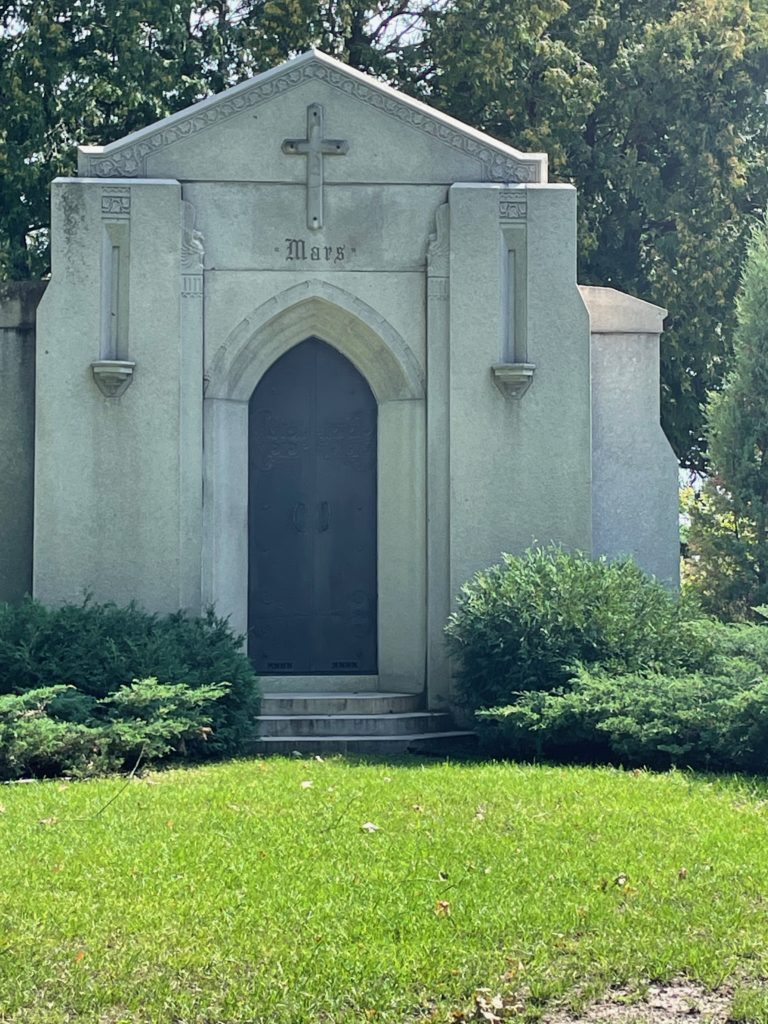Erik Visits an American Grave, Part 1,012
This is the grave of Franklin and Forrest Mars.

Born in 1883 in Hancock, Minnesota, Franklin Mars was always interested in candy and sweets. He had polio as a child, though mostly recovered. When he couldn’t move, his mom taught him how to dip chocolate candy. He was hooked for life. By the time he was 19, he was selling his own molasses chips. In 1911, he started his own candy factory, Mars Candy, in Tacoma, Washington. By this time, he was on his second marriage and his wife Ethel (also the name of his first wife) went in it with him. The factory did well at first as people do like candy but in the end it couldn’t break through because Tacoma had a more established candy maker who dominated the local market. So in 1920, they moved to Minneapolis and started a new factory there. This one really took off. By 1923, Mars’ son Forrest had come up with a new candy bar, called Milky Way, which would become the first signature item for the company. I always call the Milky Way a very solid candy bar, if not my very favorite. But in 1930, Mars came up with Snickers. Now, of the actual candy bars, Snickers is objectively the very best. One might argue for other forms of candy as better–Reese’s peanut butter cups (though not really quite my thing) or M&Ms (also of course a Mars creation, but that was the next generation). But for candy bars themselves? C’mon, there’s nothing better than a Snickers. And if anyone says Payday, they are getting banned for life. Interestingly, Mars wasn’t particularly interested in producing his own chocolate in his factory. Although Hershey was a big rival in the candy business, Mars bought his chocolate from Hershey; later the two companies merged.
Milky Way and Snickers and the other candies made Mars super rich. Like very, very, very rich. How rich? Like let’s invest in thoroughbreds level of rich. One of the horses on his gigantic Tennessee horse farm won the Kentucky Derby in 1940, though Mars himself was dead by this time. But even back then, before the Saudi oil money and billionaires of the New Gilded Age made Kentucky horse racing culture even more elite, it was still pretty damn elite. That’s what inventing good quality candy bars will do for you. By the time he built Milky Way Farm in 1930, he was living in Chicago and hobnobbing with the super rich capitalists of that city. But he really went all in on the farm. It included a 25,000 square foot house with 21 bedrooms and 12 bathrooms. It’s actually on the National Register of Historic Places today.
But Mars never really was super healthy, what with the effects of the polio and all. He developed a lot of heart problems and I don’t imagine the candy helped much with that. He died in 1934, at the age of 50, of a heart attack in his Chicago factory. I have little doubt that he was horrible to workers and hated labor unions and all that stuff, but I can’t find a lot of discussion of labor relations in his factories one way or the other.
Also buried here is Forrest Mars. Born in 1904 in Wadena, Minnesota, he was the child from Franklin’s first marriage. He was a real piece of work. He was also a very successful candy capitalist who brought M&Ms into the family in 1940 and the peanut variety in 1954. He was also a pretty awful person, known for a volcanic temper, to quote the New York Times obituary of Forrest Jr., who liked to scream at his kids. He refused to let them eat candy, except on rare occasions. Then he would call them fatties when he did relent. Real nice guy. Forrest expanded the family food empire beyond candy, including starting Uncle Ben’s Wild Rice (with its racist logo), dog food brands, and all kinds of other industrialized food products. The Uncle Ben’s invention was actually important because it was Mars’ scientists who came up with the concepts of extending the shelf life of rice. He also was such a tyrant at work that he would blow up at people if the “M” on each M&M was not perfectly centered. His own Times obituary noted that he was “legendary for his extreme temper and his fanatical behavior.” His own sons, who then later took over the business, hated their father so much that they refused to let other Mars executives speak his name. But they also evidently took over his personality and the company became known for its rampant internal paranoia. Forrest Sr. died in 1999, at the age of 95.
The Mars family today is the 3rd richest family in the United States. They are pretty reclusive and known for not giving much of anything to charity. Sounds right.
Franklin and Forrest Mars are buried in Lakewood Cemetery, Minneapolis, Minnesota.
For some reason, there is a Candy Hall of Fame. If you would like this series to visit other members of this esteemed group(??), you can donate to cover the required expenses here. Henry Heide, who created Jujyfruits and Red Hot Dollars (incidentally, these were raspberry until the 70s when they became cinnamon), is in Queens and Oliver Chase, who discovered how to make cut candy lozenges and thus helped invent both the Necco Wafer and the Valentine’s Day candy heart (my God how much evil can one man do!!) is in Boston. Previous posts in this series are archived here.


